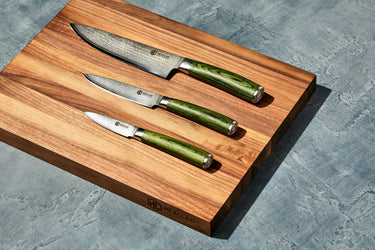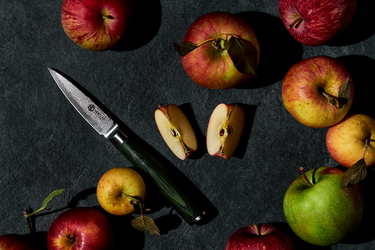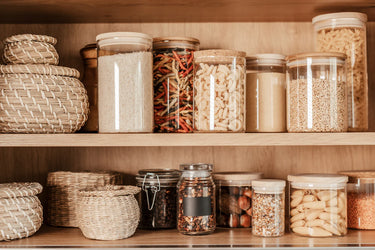Knives as a Gift: Everything You Need to Know & Avoid

While some cultures throughout history have thought that giving someone a knife was bad luck, the opposite is actually true. Nothing says good luck like high-quality knives.
Whether you’re an avid foodie or a culinary professional, knife sets contain the tools that evoke your inner chef. Utensils from a reputable knife-maker aren’t just a luxury — they’re an essential. There’s nothing more satisfying than the chop of the knife as it swiftly cuts through food. As such a versatile tool, a set of kick-butt knives would make the perfect gift for anyone's kitchen.
However, when gifting someone a set of knives, there are several factors you have to consider in your search. After all, you only want to give the best gifts to loved ones and family members. Below is a gift guide to turn to as you look for the perfect knife.
What Are the Most Common Materials for Knives?
When looking for the perfect set of knives, the quality of the tool itself is priority number one for a great knife. Material is one of the top indicators of whether the knives you’re gifting are a quality you can stand behind. This is true for a folding knife blade like a pocket knife or multitool or a fixed blade like what you’d use in the kitchen.
Carbon Steel
Carbon steel knives last longer than stainless steel blades, but they require more upkeep and maintenance. These high-quality knives keep their sharp edge for a while, reducing the stress of trying to chop various pieces of food during prep work.
Although a carbon steel knife is versatile, it does come with its downsides. For instance, due to the blade's thinness, it might become brittle over time. Compared to other knives, it’s also at a higher risk of rust and corrosion. This can be managed with seasoning and proper cleaning before and after using it, but there are lower-maintenance options with a similar kick.
Stainless Steel
Stainless steel knives are another reasonably popular option among aficionados for choosing cutlery. Where they lack in edginess compared to carbon steel knives, they certainly make up for in their low-maintenance upkeep. They’re also not as expensive as a high-quality chef's kitchen-grade knife, so you don't have to worry about the cost if you’re looking for a great gift on a budget.
A couple of downsides that you have to consider would be that due to the material, these knives are not long-lasting because they can’t be resharpened. Once they dull, they’re done for good. As a gift-giver in search of the perfect knife, sharpness is a key attribute to look for.
Ceramic
A ceramic knife is a standard for when you want a low-maintenance, easy-to-use tool. It doesn’t lose its edge like stainless and carbon steel, so you don’t have to worry about resharpening it every time you cut. Not only that, but a ceramic knife is also lightweight, so handling is a breeze.
Damascus Steel
For a tool that can help you dominate food prep with the ease of a ceramic knife, the swiftness of carbon steel, and the durability of stainless steel, look no further than Damascus steel made in Japan. It’s a steel that’ll give you a 60 Rockwell Rating (AKA a hard blade that isn’t to be trifled with), an effortlessly sharp edge, and full-tang construction for superior balance. There’s really no competition. If you’re giving the gift of a knife, Damascus steel is our top pick.
What Types of Knives Should Every Set Include?
When choosing a set of knives for gift-giving, it's essential to distinguish between each oft-used kitchen knife. Not only can this help you make sure you’re giving a full set when you mean to, but it’ll also help you identify any gaps in your recipients’ collection you might want to fill.
Chef's Knife
A chef or cook's knife is the primary knife in the set. Due to its long, broad blade, the chef's knife can quickly chop through vegetables. You can cut your food by rocking back and forth or quick mincing. Think of it as your go-to tool in the kitchen.
Paring Knife
A paring knife is a short, slim version of a chef's knife that can work on produce and harder foods like meat and potatoes. Typically, a paring can be for trimming, cutting, and peeling fruit and vegetables. It’s precision and control in one small but mighty package.
Serrated Bread Knife
A serrated knife mainly cuts bread, but it can also cut through meat, seafood, hard vegetables, and even cake. It's usually a long, narrow knife with serrated teeth on the bottom of the blade. It slices without crushing and glides through any soft underbelly.
Utility Knife
Bigger than a paring knife but still compact, the utility knife isn’t just a jack of all trades. Whether you’re making a sandwich or slicing herbs, this is a conveniently sized workhorse for beginners and masters alike.
Santoku Knife
Yeah, it’s as fancy as it sounds. If you’re going fast, this blade is running right beside you for mincing, dicing, scooping, and chopping.
Final Thoughts
Whether you are shopping for a friend or yourself, it's essential to do your research before buying kitchen knives. We hope this guide helps you with what to look out for, so you can give a gift that’s sure to make an impact.
Sources:
Stainless Steel - an overview | ScienceDirect Topics





